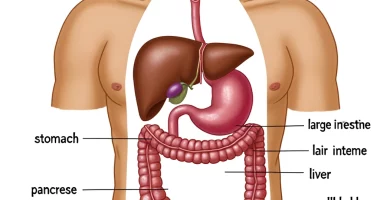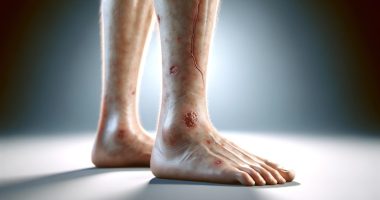Ankle arthritis
Arthritis of the ankle joint is an acute or chronic inflammatory process affecting the anatomical structures that form the articulation of the shin bones with the foot. With ankle arthritis, there is pain, hyperemia, hyperthermia, swelling in the area of the joint, and limitation of foot mobility. The diagnosis of ankle arthritis is based on the clinical picture, radiography, ultrasound, MRI of the joint, laboratory tests, diagnostic puncture, and arthroscopy. In ankle arthritis, rest, anti-inflammatory, analgesic, antibacterial drugs, and physiotherapy are indicated; arthroscopic synovectomy and joint prosthetics are performed if indicated.
General information
Ankle arthritis is an inflammatory-destructive lesion of the ankle joint elements of various genesis. Arthritis of the ankle joint can develop at any age; to a greater extent, the disease is more susceptible to males. This joint pathology is widespread throughout the world, mainly determining patients’ quality of life and causing serious concern for specialists in the field of rheumatologic orthopedics.
Reasons
Arthritis of the ankle joint can occur against the background of degenerative-dystrophic joint diseases (osteoarthritis), metabolic disorders, or systemic pathology (peripheral Bechterew’s disease, systemic lupus erythematosus) after an infection. The direct etiologic factors are:
- Systemic inflammation. Disturbance of immune reactivity in systemic diseases leads to the immune system’s perception of its joint tissues as foreign and exposure to aggressive antibodies. In rheumatoid arthritis, first of all, inflammation of the synovial membrane of the ankle joint develops, accompanied by its overgrowth, cartilage and bone tissue lesions, and fusion of joint surfaces. There are a lot of hospitals worldwide, that treat ankle rheumatoid arthritis, you can check them all here:
- https://doctor.global/results/diseases/ankle-rheumatoid-arthritis
- Infectious antigens and allergens. Reactive arthritis of the ankle joint, which occurs after bacterial and viral infections, is associated with an increased immune response to the pathogen’s antigens. When these antigens are in proximity to joint tissue antigens, reactive aseptic inflammation develops. In children, arthritis of the ankle joint is often provoked by intestinal and respiratory infections (dysentery, salmonellosis, yersiniosis, influenza, mycoplasma, and chlamydia infections), as well as allergic reactions to certain irritants (food products, plant pollen, animal hair).
- Psoriasis. Psoriatic arthritis is associated with skin lesions and develops in individuals with a hereditary predisposition.
- Gout. The persistent disturbance of the general metabolism in gout leads to an overabundance and deposition of uric acid crystals in the ankle joint cavity, which develops an inflammatory response and gouty arthritis.
- Trauma. Posttraumatic arthritis is caused by acute trauma to the joint tissues (joint capsule, cartilage, ligamentous apparatus, or muscles and tendons) due to contusions, sprains, fractures, sprains, and tears of ligaments. Prolonged physical strain on the ankle joint and flat feet causes chronic microtraumas of the joint and ligamentous apparatus of the foot, contributing to arthritis. Purulent arthritis is rare, with a penetrating wound of the ankle joint that penetrates the cavity of the pus infection or spreads from the inflammatory focus of the lymphogenic and hematogenous pathway.
Anatomy
The ankle joint is formed by the tibia, fibula, calcaneus, and talus bones; due to its complex structure, it is very mobile. Block-shaped, the ankle joint provides the foot with the functions of rotation, flexion (movement towards its plantar surface), and extension (movement towards its dorsal surface) with a range of motion of 90°. When the foot is flexed, some adduction and abduction are possible. The ankle joint is subjected to tremendous stresses, bearing the body’s weight.
Classification
Arthritis of the ankle joint can occur in acute and chronic forms. Depending on the cause, a distinction is made between primary (with direct damage to the joint) and secondary arthritis (developed against the background of extra-articular pathology). By the nature of the inflammatory process, arthritis of the ankle joint can be:
- non-specific (purulent);
- specific (tuberculosis, gonorrhea, etc.);
- aseptic (reactive, rheumatoid, etc.).
The most typical forms of ankle joint lesions are gouty, reactive, posttraumatic, psoriatic, and rheumatoid arthritis.
Arthritis of the ankle joint can develop in isolation (monoarthritis) but more often occurs simultaneously with inflammation in other joints (oligoarthritis, polyarthritis). The lesion of the ankle joint in arthritis can be unilateral (trauma, infection), bilateral (systemic pathology), or migratory (gout).
Symptoms
Acute arthritis of the ankle joint develops suddenly, more often at night. The sudden onset of pain is accompanied by rapid onset of hyperemia and swelling, local temperature increase in the area of soft tissues of the joint, significant limitation of foot mobility, and difficulty moving. Purulent arthritis of the ankle joint is characterized by general intoxication: chills, fever, weakness, and headache.
The chronic form of the disease develops gradually. Hyperemia and swelling of the ankle joint are weakly expressed; morning stiffness and painful sensations when moving, maximum flexion, and joint extension when putting on and taking off shoes.
There are several stages of arthritis development.
- In stage I, ankle pain occurs only on movement and stops at rest; stiffness and reduced foot mobility are insignificant.
- Stage II arthritis of the ankle joint manifests by constant pronounced pain that does not pass at rest, an increased pain response “to the weather”, and a marked decrease in foot mobility.
- At stage III of arthritis, due to a sharp loss of ankle joint mobility, the patient can move only with the help of a stick or crutches. The foot becomes severely deformed, assumes an unnatural position, and ankylosis develops, leading to the patient’s disability.
The clinical picture of ankle arthritis may vary depending on the cause of inflammation. Symmetrical lesions with constant pain syndrome characterize rheumatoid arthritis of the ankle joint. When the ligamentous apparatus is involved in the inflammatory process, it is accompanied by ankle instability with frequent subluxations and dislocations. A genitourinary, intestinal, or respiratory viral infection always precedes the development of reactive ankle arthritis. In Reiter’s syndrome, ankle arthritis is accompanied by eye damage (conjunctivitis) and urinary tract infection (urethritis, prostatitis).
Diagnosis
The diagnosis of ankle arthritis is based on the patient’s interview, clinical picture, radiographs, ultrasound, CT and MRI of the ankle joints, and laboratory tests:
- X-rays. Radiography in ankle arthritis allows you to detect signs of osteoporosis, the presence of fluid or pus in the joint cavity; erosions, cysts, destructive changes in the bone substance, flattening of the articular surfaces, reduction of the articular gap; ankylosis.
- MRI. MRI of the ankle joint is more informative, as it reveals even minor abnormalities in bone tissue, articular cartilage, ligaments, and soft tissues.
- Tests. From laboratory examination methods, general and biochemical analysis of blood and urine, ELISA, examination of rheumatoid factor, and blood culture for sterility are performed.
- Additional diagnostics. If necessary, a diagnostic puncture with examination of synovial fluid or arthroscopy with biopsy of joint tissues is performed.
Treatment of ankle arthritis
The treatment of ankle arthritis is carried out by a rheumatologist or orthopedic traumatologist and includes complex drug and non-drug therapy. In arthritis of the ankle joint, a regime with minimal load on the foot is indicated: complete rest or immobilization with an elastic bandage; when walking, the use of a cane; and diet with the exclusion of fatty, salty, spicy, smoked, and canned food.
- Drug therapy. Pharmacotherapy includes NSAIDs, analgesics, corticosteroids (intra-articular injections, periarticular blockades, systemic therapy), broad-spectrum antibacterial drugs (in case of infectious genesis), and vitamins.
- Orthopedic correction. It is recommended to wear orthopedic shoe inserts or specially-made shoes.
- Physiotherapy. In arthritis of the ankle joint outside the exacerbation, physiotherapy procedures (UV, electrophoresis, mud treatment), massage, and therapeutic gymnastics are prescribed.
- Orthopedic surgeries. In purulent arthritis, arthroscopy with drainage of the ankle joint cavity is performed. In persistent, recurrent rheumatoid arthritis, arthroscopic synovectomy is indicated. In severe deforming forms of the disease, arthroscopic arthrodesis of the ankle joint or endoprosthesis is required.
All these treatment options are available in more than 760 hospitals worldwide (https://doctor.global/results/diseases/ankle-rheumatoid-arthritis). For example, Foot and ankle arthroscopy can be done in 29 clinics across Turkey for an approximate price of $3.2 K (https://doctor.global/results/asia/turkey/all-cities/all-specializations/procedures/foot-and-ankle-arthroscopy).
Prognosis and prevention
Arthritis of the ankle joint is prone to a long recurrent course. The cause of arthritis determines the prognosis: in the reactive form, it is more favorable; in rheumatoid and psoriatic lesions, leading to severe deformity and loss of motor activity of the ankle joint, it is more serious. Prevention of inflammatory-destructive joint lesions includes correcting lifestyle, diet, body weight, avoiding harmful habits, maximal motor activity, and timely treatment of infectious diseases and injuries.



